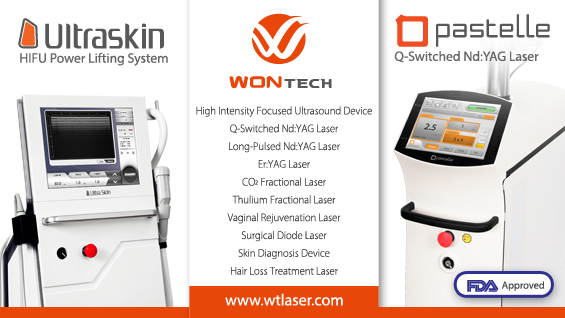
The second group with the 3-0 multiple bidirectional cog PDO thread was also subjected to a free fall while adding the number of strands in the same manner as in the first group. When the rat was dropped after inserting one 3-0 multiple bidirectional cog PDO strand, the rat dangled on the thread for 26 seconds before the thread broke.
Two, three and four strands all supported the rat’s weight without slipping off or breaking. Due to the short bidirectional cogs, tissue contouring seen with the bidirectional cog PDO thread was not observed in the second group. The entire length of the subcutaneously placed thread remained in the tissue (Figure 5).
.png)
Figure 5. Due to short bidirectional cogs that face each other, the multiple bidirectional cog PDO thread did not cause tissue contouring near the entry point and maintained the full length of the thread originally placed in the skin.
As for the Group 2-A, where strands were placed in a fan shape, a triangular flap was observed. In Group 2-B, where parallel strands were placed, a rectangular flap was observed (Figure 6).

Figure 6. In Group A, where the strands were inserted in a fan shape, a triangular flap was observed, whereas in Group B, where strands were inserted parallel to each other, a rectangular flap was observed.
When the 3-0 multiple bidirectional cog PDO thread was forcibly removed from the rat skin, the thread did not pull out easily. Those that were pulled out with more force had deformed or ripped cogs (Figure 8).

Figure 8. First cogs were distorted or torn.
To examine in what shape the 3-0 multiple bidirectional cog PDO threads remained in the tissue, we harvested the skin tissues. We found that the first of the small bidirectional cogs that face each other was caught onto the tissue and this formed a wave-like pattern in the skin (Figure 9).

Figure 9. The first of the small bidirectional cogs that face each other in the tissue snag onto the tissue and formed a wave-like pattern in the skin.
Based on the results of this study, we concluded that the multiple bidirectional cog PDO withstood a greater gravitational pull than the bidirectional cog PDO thread in proportion to the number of the bidirectional cogs that face each other. Second, we also found the first pair of the cogs facing each other are the ones responsible for holding onto the skin tissue. Third, as for the bidirectional cog PDO, at least two strands had to be used to withstand the 260g body weight of a rat. Fourth, the bidirectional cog PDO thread was likely to cause tissue contouring and wrinkles at the suture entry point and shorten in length when pulled. However, the multiple bidirectional cog PDO thread does not cause contouring and does not create wrinkles at the entry point. The threads do not shorten in length and maintain the entire length originally inserted.
[Advertisement] Ultra Skin/Pastelle – Manufacturer: WONTECH(www.wtlaser.com)
White Rat Experiment 2 (Dermaspring)
Dermaspring was developed to increase the volume enhancing effect of the previous monofilament PDO thread for use in nasolabial grooves, marionette lines, midcheek grooves, or combining with other treatments. We investigated whether Dermaspring maintained its spring-like shape after subcutaneous insertion.
1. Method
The dorsal skin of the white rat was shaved to expose the skin. The rat was anesthetized using ether. A 23G needle was used to create a small opening in the skin of a 260g white rat and three Dermasrping strands were inserted overlapping each other for volume enhancement. And the skin flap was harvested for examining the shape of subcutaneously inserted Dermaspring strands.
2. Results
After three strands of Dermaspring were subcutaneously placed in the dorsal skin of a white rat, lumps could be seen on the skin surface (Figure 10).

Figure 10. After subcutaneous placement of three strands of Dermaspring, lumps on the white rat skin could be seen.
In the harvested skin flap, the original shape of the Dermaspring was observed. It is expected that unlike previous twisted threads, new fiber tissues will generate in a cylindrical shape around the spring-like strands adding to collagen volume in the area (Figure 11).

Figure 11. Unlike previous twisted thread, new fiber tissues accumulated around the spring-like structure of Dermaspring and we expect this will help form a cylindrical collagen volume.
-To be continued




















